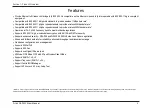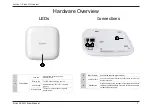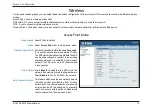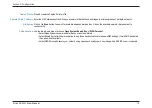
4
D-Link DAP-2330 User Manual
Section 1 - Product Overview
Product Overview
Introduction
D-Link, an industry pioneer in wireless networking, introduces a solution for businesses seeking to deploy next generation 802.11n LANs. D-Link unveils
its new DAP-2330, designed specifically for environments with high traffic areas such as airports, coffee shops, shopping centers, sporting venues, and
school campuses to provide secure and manageable dual band wireless network options for network administrators.
Versatile Access Point
The DAP-2330 Access Point allows network administrators to deploy a highly manageable and extremely robust dual band wireless network. For
advanced installations, this new high-speed Access Point has integrated 802.3af Power over Ethernet (PoE) support, allowing installation of this device in
areas where power outlets are not readily available. In addition to bridging 802.11b/g/n wireless networks, the DAP-2330 can bridge to wired networks
with its integrated Gigabit (10/100/1000Mbps) Ethernet port.
Enhanced Performance
The DAP-2330 delivers reliable wireless performance with maximum wireless signal rates of up to 300Mbps. This, coupled with support for Wi-Fi
Multimedia™ (WMM) Quality of Service features, makes it an ideal access point for audio, video, and voice applications.
Security
To help maintain a secure wireless network, the DAP-2330 provides the latest in wireless security technologies by supporting both Personal and Enterprise
versions of WPA and WPA2 (802.11i) with support for RADIUS server back end. To further protect your wireless network, MAC Address Filtering, Wireless
LAN segmentation, Disable SSID Broadcast, Rogue AP Detection, and Wireless Broadcast Scheduling are also included.
* Maximum wireless signal rate derived from IEEE Standard 802.11g and 802.11n specifications. Actual data throughput will vary. Network conditions and environmental factors, including volume of network traffic,
building materials and construction, and network overhead, lower actual data throughput rate. Environmental conditions will adversely affect wireless signal range.





































